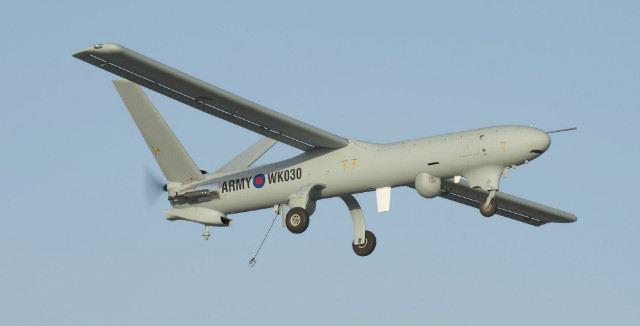An investigation into the crash of a British Army Thales Watchkeeper unmanned air vehicle in 2014 has concluded that the system had determined that the aircraft had already landed, despite it still being some 10-15ft off the ground.
The UAV was carrying out a training sortie at West Wales Airport on 16 October 2014, when it “pitched rapidly nose down” because it thought it was slowing on the ground. The crash caused it to be written off.
The UK Military Aviation Authority’s report into the incident was publicly released on 12 August. In this, it said weather conditions led the crew to take precautionary measures that resulted in the Watchkeeper thinking it had landed, and pitching into the ground.
Aircraft WK031 had completed post-production flight testing in June 2014, and had flown for some 13h. The incident sortie was being flown by civilian operators and was being used for both type conversion and currency flight purposes.
The Watchkeeper flew up to 5,000ft after take-off, and entered the D201 danger zone that it was permitted to fly in. During this phase of the flight, the narrowband datalink dropped out four times, the report notes, but managed to reconnect itself.

Crown Copyright
Meteorological reports indicated that there would be thunderstorms, and it was decided that the mission should come to an end after 90min of flight.
“The crew selected ‘altitude difference override’ because of their concerns about laser altimeter performance over a wet runway, mindful that the system’s safety logic would automatically abort the approach if it detected a height discrepancy,” the report says.
Because of these concerns, the crew put the Watchkeeper into “master override” mode, which would stop the system entering the automatic abort mode, and subsequently make the system “override every inherent safety abort mechanism”.
Entering into the final stages of its landing approach, the aircraft met the automatic take-off and landing (ATOL) element of the flight, and the radar was locked. However, due to turbulent weather, the vehicle management system computer incorrectly indicated that a ground touch had been made with the runway. This caused the system to pitch forward as it would to slow down after landing, but as it was still in the air, it nose-dived and crashed.
The ATOL system also informed the crew that the UAV had landed, even though it had not. “The crew in the ground control station were unaware that an accident had occurred until a ‘crash’ call was received on the WWA [West Wales Airport] tower frequency,” the report says.
The crew tried to cut the engine once it realised that the datalink had been lost and the distress call had been made, but this had no effect.
The army has 54 Watchkeepers on order, and the system is also being pitched to Poland for its Gryf requirement.
Source: FlightGlobal.com



















